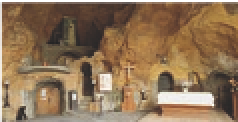Travel Reference
In-Depth Information
Left
St Stephen's Basilica
Centre
Rose window, Mátyás Church
Right
Interior, Cave Church
Places of Worship
!
St Stephen's Basilica
19th-century Jews to assimilate
into Hungarian society. The twin
towers, for example, are clearly
inspired by Christian church
steeples. During World War II,
the synagogue was used as a
detention centre and also acted
as the centre of the Budapest
ghetto
(see p84)
.
$
Cave Church
The grandest of Budapest's
many spectacular churches is it-
tingly named after the country's
irst king, St Stephen. Built in the
latter part of the 19th century, it
dominates the city skyline and
can be seen from most parts of
Budapest
(see pp12-13)
.
@
Mátyás Church
Mátyás Church has been a
piece of Budapest history since
the 13th century. It has been the
stage for a number of seminal
events, including the marriage of
King Mátyás, and the coronations
of Franz József I in 1867 and
Charles IV in 1916
(see pp24-5)
.
£
Great Synagogue
The remarkable Cave Church
was built into Gellért Hill by
Pauline monks following a
pilgrimage to Lourdes. It was
consecrated on Whit Sunday
1926. Bricked up during the
Communist period, it reopened
in August 1989
(see p69)
.
%
Inner City Parish Church
Completed in 1859, this is
the largest synagogue in Europe.
Its design betrays the desire of
Almost destroyed to make
way for Elizabeth Bridge
(see
p42)
when it was being rebuilt
after World War II, the Inner City
Parish Church was miraculously
saved when the builders had a
last-minute change of heart. The
oldest building in Pest, dating
from the 14th century, it was
damaged by ire in 1723 and
rebuilt by György Pauer in 1725-
39. Don't miss the vaulted
Gothic chapel
(see p83)
.
^
St Anne's Church
The twin-towered parish
church of Víziváros is one of
the most beautiful Baroque
churches in Hungary. Built from
1740 to 1805, its highlights
include the painted ceiling by
Gergely Vogl, the high altar and
Figure of St Florian, Inner City Parish Church
40






































































































